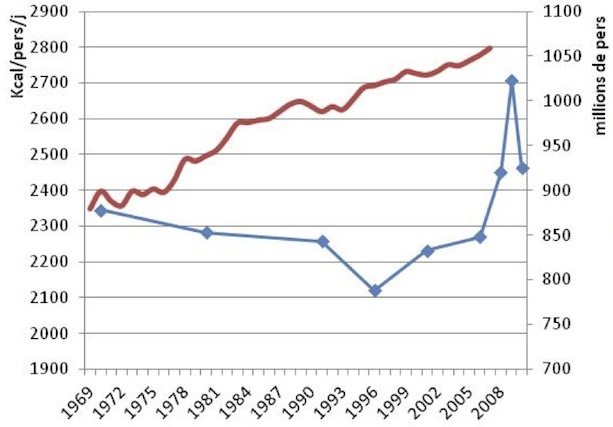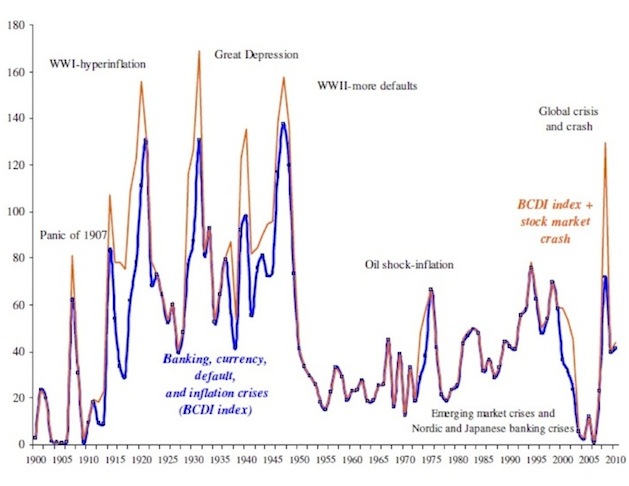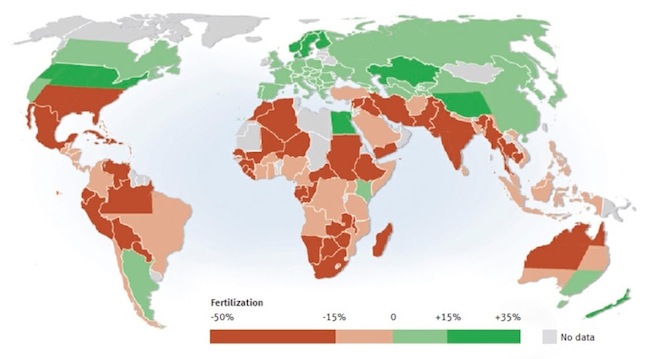The problem of food security is exposed to considerable stress due to the number and variety of issues it involves.
Tensions and volatility
The current context is riddled with paradoxes. It is theoretically possible to feed the seven billion people who live on the planet. While population growth has been extremely rapid, each person can theoretically have access to 3000 kilocalories per day. On average, a person needs 2200 kcal to stay in good health. This figure could be adjusted: a teenager, for example, has more needs than a senior. Moreover, not all parts of food are comestible (peelings…). And yet, today, despite the 3000 kcal available, we are faced with poverty and a situation where overeating and undernourishment coexist. In fact, the problems are more related to the inequality of distribution than to quantity. The Indian economist Amartya Sen very aptly described this issue: famine doesn’t occur because there isn’t enough to eat, but because some people simply don’t have access to the available resources.
Food availability while 925 million men are still undernourished

Red: food availability (in kcal/person)
Blue: number of undernourished people
Source: FAO-STAT data
|
Nevertheless, this is only one of the aspects of the problem. A second set of issues relates to the pressure on the environment. In a near future, the middle class population will increase significantly. Access of hundreds of millions of people to mass consumption will generate tensions on all resources. Mineral and energy resources are already under heavy stress. The problem will inevitably arise regarding food resources. Not only will demand increase, it will also change in nature. History shows us that each time men have become richer, they first wanted to eat their fill, then to diversify their diet, and eventually, to gain access to foods of animal origin, as a sign of a higher social status. This pattern of development is not restricted to OECD countries, it is a general tendency. While not all countries seek the same animal products (milk in India, fish in Japan, different meats elsewhere), this overall evolution reflects a universal and systematic tendency. One can easily imagine the impact in terms of agricultural production when it takes an average of three vegetable calories to produce one animal calorie.
These stress factors contribute to new volatility in agricultural prices, a constantly growing phenomenon which no longer corresponds to the simple adjustment of supply and demand. There are many causes, among which the sharp increase in demand due to demographics, global growth and food transition in many countries are not the least important. Extreme events associated with climate change also have a significant effect on increasing those tensions and generating uncertainty. Nevertheless, price volatility also reveals a chronic underinvestment in agriculture at global level: partly because of low food prices at the end of the twentieth century, there has been little investment in agriculture during the last decades. One last factor should also be considered: the interaction between energy and agricultural production, with the use of certain cereals to produce biofuels. Today, in some regions of the world, food prices are directly linked to fuel prices.
Volatility’s come back

Source: Rheinart, 2010
|
While the volatility of agricultural prices in developed countries is barely perceptible, elsewhere, the situation is quite different. When prices are too high, the urban poor can no longer afford to buy cereals, a staple of their diet. This is what happened in 2008 in 32 countries severely impacted by these imbalances. Important demonstrations followed. Similar problems regularly hit rural areas, but they receive much less media coverage… This issue also reveals another consequence of volatility: when prices are too high, the problem hits the poor; when prices are too low, they hit producers. Poor producers are hit in all cases. More generally, volatility hurts investment because investors hate unpredictable situations.
Clouds on the horizon
Human pressure on the environment is expected to continue to increase. The world population is increasing, but as we have already pointed out, the growth of the middle class is crucial in this regard. It goes hand in hand with an increasing urbanization and its consequences include the critical issue of water. If we take the example of France, a country located in the temperate zone and that isn’t part of the most densely populated countries in Europe, only 3% of the water that rains each year is used without being restituted to the environment – a relatively modest figure. And yet, this situation doesn’t protect the agricultural sector from tensions. The cultivation of maize crops in the south-west it is strongly linked to the declining levels of groundwater: water resources suffer from a competition for different uses, while the problem of scarcity is also beginning to appear.
At a global level, the problem also affects the soil. The renewal of this often overlooked resource is very slow: according to the kind of rock, it takes between 50 and 1000 years to create a 1-cm layer of soil. Unfortunately, the action of erosion is much faster.
Soil also raises the issue of biodiversity, one of the most sensitive parameters of the problem. Soil is a living « organism », hosting billions of bacteria and an abundant fauna that contribute to the degradation of materials that become nutrients for plants. The physical and biological fragility of soil is a potential factor of scarcity. Agronomists are working on these issues because it is crucial to understand what kind of bacterial medium makes a land productive or not, what genetic resources are available, etc. In France, for example, 10 000 species of wheat are preserved in order to create new varieties in the future by using diversity from the past. Biodiversity is therefore a factor of resilience. In a highly bio-diverse environment, when the environment changes, only part of the plants, fauna and microbes are adapted to the new conditions. However, in extremely typical and poorly varied environments, the chances of adaptation of these life-forms are very slim.
In fact, the evolution of the environment is another parameter to take into account. Since 1950, there has been a steady increase in yields through the use of fertilizers and mechanization. This is what allowed to feed the growing world population. But we are currently experiencing a plateau, related mostly to climate change. On the 3000 analyzed cases, the phenomenon is subtle: plants grown in France today and that have a better yield than those of fifty years ago, are no longer adapted to three consecutive days of drought. In other words, the highest yields were obtained under conditions that climate change can alter. The same phenomenon can be observed across Europe and on a global scale: with a few exceptions, especially in North America, this yield plateau is observed worldwide. The tendency is certainly not inevitable: innovation can help us find new solutions; as we already know, not all plants react the same way to environmental change. But for now, the situation is highly problematic.
Estimated effects of climate change on agriculture production, in 2080

Image Hugo Ahlenius, UNEP/Grid-Arendal
|
Due to the tension on the environment and to climate change, the dramatic increase in agricultural productivity that occurred between 1960 and 2000 can not be renewed during the coming decades. However, there is some leeway, not only in terms of supply (ie agricultural production), but also in terms of what may be called the demand, that is to say, regarding the consumers and what is lost at different steps of the chain.
The crucial issue of loss and waste takes a variety of forms: locusts in African countries, 30% of waste by consumers in Western countries… In total, at a global scale, between 30% and 50% of what is produced is lost or wasted. This is a significant figure and even if it seems unrealistic to consider a complete elimination of losses, it is possible to increase public awareness. Large scale policies have been implemented in this regard in Britain but also in France and in the United States. The fight against food waste is therefore a crucial factor for ensuring the sustainability of food systems and can be achieved by different ways: by reducing losses directly in the fields, by taking into better account the processing factors between plant and animal calories, by the limitation of distribution/consumption losses…
Similarly, to determine if it is possible to feed an expected Earth population of nine billion people by 2050, it is important to predict the diet of the world’s population. Today, it is striking to witness the coexistence of situations of malnutrition and food shortages on one hand, and of overweight and obesity on the other. This phenomenon is new in all parts of the world. The coexistence of over- and under-nutrition is no longer a division between the North and the South, but between different populations within North and South.
What are the possibilities?
What possibilities can we create in an environment where demand is increasing and natural resources are under pressure?
It should first be noted that climate change will have different effects on agricultural production, including the relocation of production areas. It seems clear that some regions, such as countries of the former USSR, have more edges than others, like the tropics. This will give birth to a new geography, because all plants don’t react the same way to these changes. Wheat or corn, for example, are starting to show yield problems, unlike rice. It will be necessary to act on different parameters: production areas, the kinds of crops that are cultivated, and of course, on innovation, to adapt crops to changing conditions.
The issue of land scarcity is also raised, since only a portion of the 13 million hectares of emerged lands on the planet is cultivable. Agricultural lands represent approximately 5 billion ha. However, it is estimated that urbanization confiscates about 10 million hectares per year, or one billion ha in a hundred years – a considerable figure. Urban densification is urgently needed, something town-planners have understood. But this won’t be enough: we should revise, for example, the waterproofing of roads and parking lots, develop techniques for the percolation of water to prevent the acceleration and increase of streaming that leads to problems such as erosion and drought…
The question does not arise everywhere in the same terms. In a country like China, which has 7% of arable land and hosts nearly 30% of the world population, the pressure on arable land is much greater than in any European countries and while new populations settle in long-standing agricultural regions, this pressure is likely to increase. Settlements extend therefore at the expense of areas reserved for agriculture. The government considers, and rightly so, that food security is one of the strategic elements for the future. Compliance with the five-year plan implies an increase of arable land and leads the Chinese to buy land abroad.
There are many sources of productivity. Today, between an African village without means and a farm in a developed country, the difference in the yield of wheat may vary from 1 to 1000. Obviously, it is possible to make transfers of know-how… but this could eventually raise problems, including competition on water resources.
Another determining factor in agricultural production: plants, which exist through photosynthesis, are a renewable source of carbon. In a world where energy demand is growing steadily, where there are few alternatives other than oil for liquid fuel, biofuel appears to be part of the solution. The development of more efficient biofuels is therefore a crucial issue. Today, we only use the grain of wheat or the root – a very small part of the plant. By breaking down lignocellulose, in other words, the stems and leaves, the yield of biofuel production compared to the available biomass would be five-fold. Not to mention the prospects of growing algae with photosynthesis. In any case, if crops are to be used increasingly in the energy sector, a great deal of innovation will be necessary because at the moment, the transformation processes are using far too much vegetable matter.
There are pressures everywhere, at all levels, but with a shared diagnosis of the situation, progress can be achieved. Since 2008, many international summits dedicated to food security share the same analysis of the global situation. This is evidenced by the G20 decisions aimed at a better understanding of food stocks in the world. Depending on circumstances, it may be decided, in a concerted way, to increase or even to exchange information, to avoid a repetition of the 2008 situation: in the 32 countries affected by the crisis, food prices remained very expensive for several weeks after the resolution of the problem at the international level because speculators took advantage of the lack of information to maintain artificially high prices. The dissemination of information is seen as an effective way to fight against excessive volatility. Following the Americans, the regulation of new markets for agricultural raw commodities in order to avoid excessive speculation is also on the agenda. Efforts to reduce losses and waste, but also an increased awareness of the need to reinvest in the agricultural sector in order to meet demand for years to come, are all sources of progress.